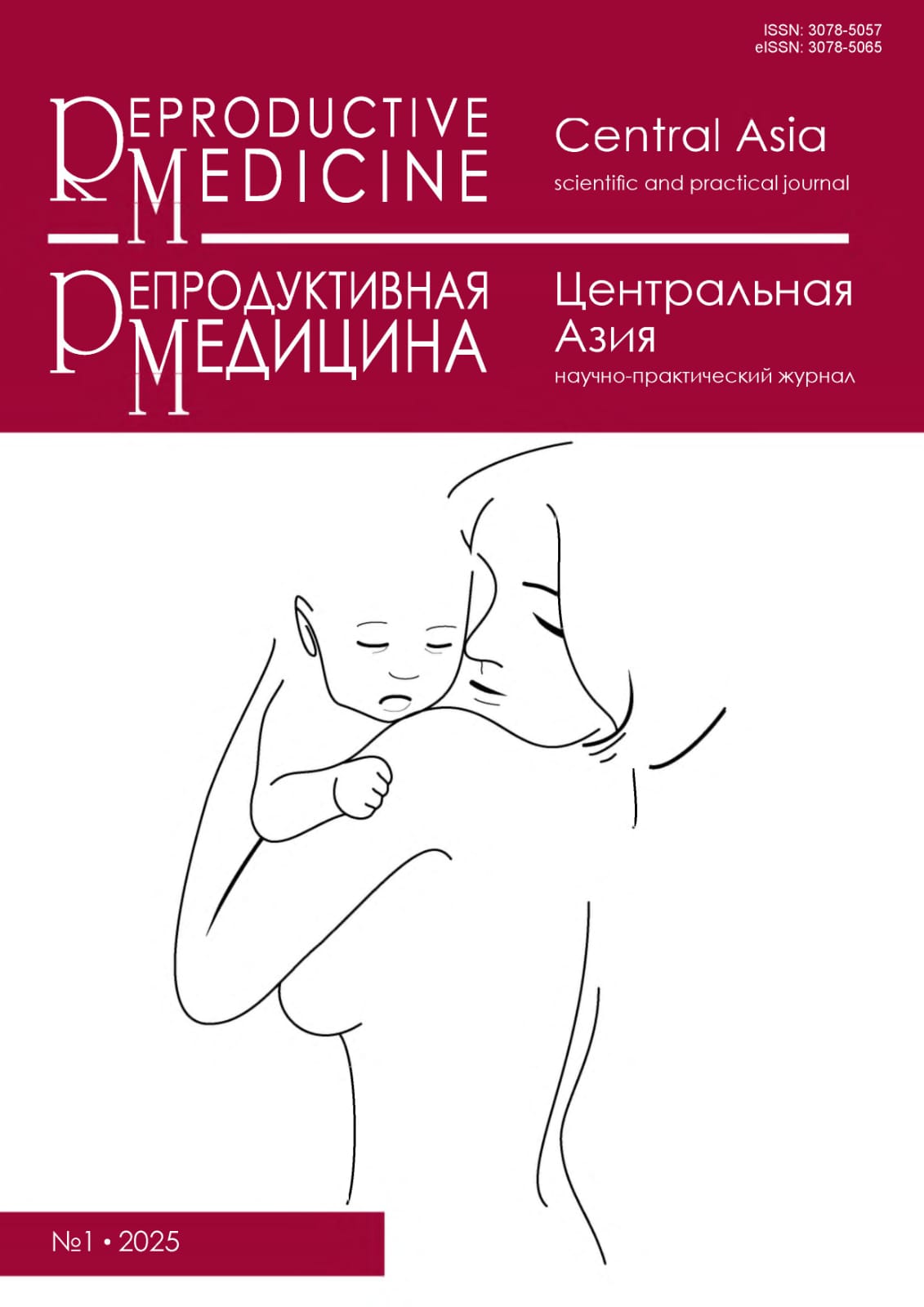Optimization of treatment of antiphospholipid syndrome in pregnant women: Clinical research
DOI:
https://doi.org/10.37800/RM.1.2025.420Keywords:
antiphospholipid syndrome, pregnancy, systemic enzyme therapy (SET), plasmapheresisAbstract
Relevance: Antiphospholipid syndrome (APS) is a very complex and urgent problem during pregnancy. APS is characterized by venous and arterial thromboses caused by the circulation of antiphospholipid antibodies in the blood. These thromboses lead to various complications and negative consequences of pregnancy, requiring improved therapy.
The study aimed to optimize management of antiphospholipid syndrome in pregnant women.
Materials and Methods: The study was conducted among 76 pregnant women with APS, divided into 2 groups. The groups were representative regarding age, parity, obstetric, and somatic pathology but differed in treatment methods. The comparison group (traditional therapy) included 28 pregnant women with APS. In this group, all pregnant women received traditional APS therapy, including anticoagulants, antiplatelet agents, and glucocorticoids. The main group included 48 pregnant women with APS. In this group, all pregnant women, in addition to traditional therapy, were given systemic enzyme therapy (SET) and plasmapheresis. The control group included pregnant women with uncomplicated pregnancy, n=30.
Results: After 30 days of treatment, the changes in the traditional therapy group compared to the controls included the increases in Willebrand factor – by 17.7%, platelet aggregation index – by 24.1%, total platelet aggregation index – by 26.2%, soluble fibrin-monomer complexes (SFMC) – by 55.3%, and early fibrin degradation products (EFDP) – by 45.6% (p<0.05). The platelet disaggregation index decreased by 18.5% and antithrombin III activity by 14.3% (p>0.05). Multidirectional trends in hemostasis system parameters recorded during traditional therapy generally aggravated the degree of disturbances registered in the initial period of the study.
The treatment provided more significant dynamics toward normalizing the studied parameters in the main group. Reliable differences were revealed with the indicators obtained with traditional therapy: SFMC – by 29.7%, EFDP – by 23.3%, and blood prothrombin time – by 14.0% (p<0.05).
Conclusion: Using SET in combination with plasmapheresis and low molecular weight heparin ensures the normalization of hemostasis system parameters in pregnant women with APS.
References
Tripodi A, Cohen H, Devreese KMJ. Lupus anticoagulant detection in anticoagulated patients. Guidance from the Scientific and Standardization Committee for lupus anticoagulant/antiphospholipid antibodies of the International Society on Thrombosis and Haemostasias. J Thromb Haemost. 2020;18(7):1569-1575.
https://doi.org/10.1111/jth.14846
Devreese KMJ, Zuily S, Meroni PL. Role of antiphospholipid antibodies in the diagnosis of antiphospholipid syndrome. J Transl Autoimmun [Internet]. 2021;4:100134. https://doi.org/10.1016/j.jtauto.2021.100134
Yun Z, Duan L, Liu X, Cai Q, Li C. An update on the biologics for the treatment of antiphospholipid syndrome. Front Immunol [Internet]. 2023;14:1145145.
https://doi.org/10.3389/fimmu.2023.1145145
Yin D. Evaluation and optimization of laboratory criteria for Antiphospholipid Syndrome Diagnosis [Internet] [Doctoral Thesis]. [Maastricht University]; 2021.
Available from: https://doi.org/10.26481/dis.20211027dy
Cohen H, Cuadrado MJ, Erkan D, Duarte-Garcia A, Isenberg DA, Knight JS, Ortel TL, Rahman A, Salmon JE, Tektonidou MG, Williams DJ, Willis R, Woller SC, Andrade D. 16th International Congress on Antiphospholipid Antibodies Task Force Report on Antiphospholipid Syndrome Treatment Trends. Lupus.2020;29(12):1571-1593.
https://doi.org/10.1177/0961203320950461
Moore GW. Analytical dilemmas in lupus anticoagulant detection. Explor Immunol [Internet]. 2023 Aug 31 [cited 2024 Mar 25];3(4):300-324.
https://doi.org/10.37349/ei.2023.00104
Balbi GGM, Pacheco MS, Monticielo OA, Funke A, Danowski A, Santiago MB, Staub HL, Rêgo J, de Andrade DCO. Antiphospholipid Syndrome Committee of the Brazilian Society of Rheumatology position statement on the use of direct oral anticoagulants (DOACs) in antiphospholipid syndrome (APS). Adv Rheumatol. 2020;60(1):29.
https://doi.org/10.1186/s42358-020-00125-9
Cohen H, Efthymiou M, Devreese KMJ. Monitoring of anticoagulation in thrombotic antiphospholipid syndrome. J Thromb Haemost. 2021;19(4):892-908. https://doi.org/10.1111/jth.15217
Khamashta M, Taraborelli M, Sciascia S, Tincani A. Antiphospholipid syndrome. Best Pract Res Clin Rheumatol. 2016;30(1):133-148.
https://doi.org/10.1016/j.berh.2016.04.002
Sciascia S, Khamashta MA, D'Cruz DP. Targeted therapy in antiphospholipid syndrome. Curr Opin Rheumatol. 2014;26(3):269-275.
https://doi.org/10.1097/BOR.0000000000000051
Космуратова Ш.Б., Битемирова Ш.К., Жакиева Ш.С., Жылкайдар Г.М., Кайсажанова Г.А. Клинико-анамнестические факторы риска развития преэклампсии. Репродуктивная медицина (Центральная Азия).2024;2:80-87.
Kosmuratova ShB, Bitemirova ShK, Zhakieva ShS, Zhylkajdar GM, Kajsazhanova GA. Clinical and anamnestic risk factors for developing preeclampsia. Reproductive medicine (Central Asia). 2024;2:80-87. Russian
https://doi.org/10.37800/RM.2.2024.80-87
Тайжанова Д.Ж., Зубков Д.В., Комличенко Э.В., Магалов И.Ш., Сорокина М.А., Амирбекова Ж.Т., Турдунова Г.С., Беспалова Н.В., Майданова З.О. Оценка параметров коагулограммы для прогнозирования потери беременности на ранних сроках. Репродуктивная медицина (Центральная Азия). 2024;3:82-91.
Tajzhanova DZh, Zubkov DV, Komlichenko JeV, Magalov ISh, Sorokina MA, Amirbekova ZhT, Turdunova GS, Bespalova NV, Majdanova ZO. Evaluation of coagulogram parameters for predicting early pregnancy loss. Reproductive medicine (Central Asia).2024;3:82-91. Russian. https://doi.org/10.37800/RM.3.2024.82-91
Legault K, Schunemann H, Hillis C, Yeung C, Akl EA, Carrier M, Cervera R, Crowther M, Dentali F, Erkan D, Espinosa G, Khamashta M, Meerpohl JJ, Moffat K, O'Brien S, Pengo V, Rand JH, Rodriguez Pinto I, Thom L, Iorio A. McMaster RARE Best practices clinical practice guidelines on diagnosing and managing the catastrophic antiphospholipid syndrome. J Thromb Haemost.2018;16:1656-1664.
Devreese KMJ, Ortel TL, Pengo V, De Laat B. for the Subcommittee on Lupus Anticoagulant/Antiphospholipid Antibodies. Laboratory criteria for antiphospholipid syndrome: communication from the SSC of the ISTH. J Thromb Haemost. 2018;16(4):809-813. https://doi.org/10.1111/jth.13976
Garcia D, Erkan D. Diagnosis and management of the antiphospholipid syndrome. N Engl J Med. 2018;378(21):2010-2021.
https://doi.org/10.1056/NEJMra1705454
Cohen H, Mackie IJ, Devreese KMJ, International Society for Thrombosis and Haemostasias Scientific and Standardization Committee for Lupus Anticoagulant/Antiphospholipid Antibodies. Clinical and laboratory practice for lupus anticoagulant testing: An International Society of Thrombosis and Haemostasias Scientific and Standardization Committee survey. J Thromb Haemost. 2019;17(10):1715-1732.
https://doi.org/10.1111/jth.14560
Tripodi A, Cohen H, Devreese KMJ. Lupus anticoagulant detection in anticoagulated patients. Guidance from the Scientific and Standardization Committee for lupus anticoagulant/antiphospholipid antibodies of the International Society on Thrombosis and Haemostasias. J Thromb Haemost. 2020;18(7):1569-1575.
https://doi.org/10.1111/jth.14846
Arachchillage DRJ, Gomez K, Alikhan R, Anderson JAM, Lester W, Laffan M, British Society for Haematology, Haemostasis and Thrombosis Taskforce. Addendum to British Society for Haematology Guidelines on Investigation and Management of 112 Reproductive Medicine (Central Asia) 2025, no. 1 Original research Репродуктивная медицина (Центральная Азия) 2025, №1 Оригинальные исследования Antiphospholipid syndrome, 2012 (Br J Haematol. 2012;157:47-58.): use of direct-acting oral anticoagulants. Br J Haematol. 2020;189:212-215. https://doi.org/10.1111/bjh.16308
Опыт применения препаратов системной энзимотерапии (Вобэнзим) в акушерстве и гинекологии. Медицинские новости. 2019;4 (295):56-59.
Experience of using systemic enzyme therapy drugs (Wobenzym) in obstetrics and gynecology. Meditsinskie novosti. 2019;4 (295):56-59. Russian
Petri M. Improvements in diagnosis and risk assessment of primary and secondary antiphospholipid syndrome. Hematol Am Soc Hematol Educat Progr. 2019;2019(1):415-420. https://doi.org/10.1182/hematology.2019000046
Федорова А.Т., Серов В.Н., Сидельникова В.М. Применение плазмафереза в лечении патологических состояний в акушерстве [Интернет]. Дата доступа: 17.01.2025. Доступно по адресу:
Fedorova AT, Serov VN, Sidelnikova VM. Use of plasmapheresis in the treatment of pathological conditions in obstetrics [Internet]. Access date: 17.01.2025. Russian.
Available at: https://www.critical.ru/ann/pages/it_page30.html
Pengo V, Denas G. Diagnostics and treatment of thrombotic anti-phospholipid syndrome (APS): A personal perspective. Thromb Res.2018;169:35-40. https://doi.org/10.1016/j.thromres.2018.07.011
Танышева Г.А., Желпакова М.С., Маусымбаева Н.Б., Курмангалиева Д.А., Сидорова О.Г. Способ прегравидарной подготовки женщин с антифосфолипидным синдромом и его клинические результаты. Наука и здравоохранение. 2015;6:124-132.
Tanysheva GA, Zhelpakova MS, Mausimbaeva NB, Kurmangaliyeva DA, Sidorova OG. Method of pregravid preparation of women with antiphospholipid syndrome and its clinical results. Nauka i zdravookhranenie. 2015;6:124-132. Russian.
Downloads
Published
How to Cite
Issue
Section
License
Copyright (c) 2025 The rights to a manuscript accepted for publication are transferred to the Journal Publisher. When reprinting all or part of the material, the author must refer to the primary publication in this journal.

This work is licensed under a Creative Commons Attribution-NonCommercial-NoDerivatives 4.0 International License.
The articles published in this Journal are licensed under the CC BY-NC-ND 4.0 (Creative Commons Attribution – Non-Commercial – No Derivatives 4.0 International) license, which provides for their non-commercial use only. Under this license, users have the right to copy and distribute the material in copyright but are not permitted to modify or use it for commercial purposes. Full details on the licensing are available at https://creativecommons.org/licenses/by-nc-nd/4.0/.




